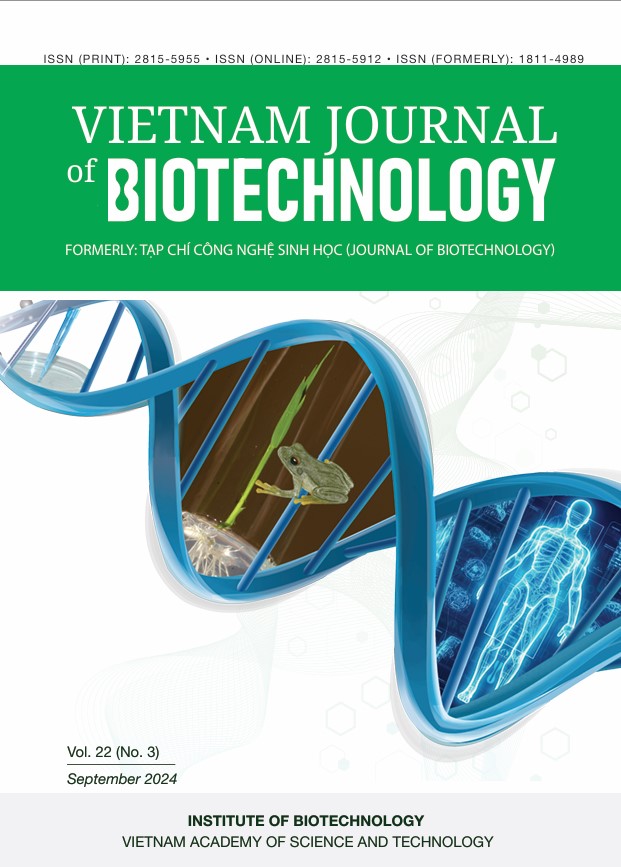Evaluation of the protection of astaxanthin on human hair follicle palilla cells against the aging effects triggered by hydrogen peroxide
Author affiliations
DOI:
https://doi.org/10.15625/vjbt-20532Keywords:
Anti-aging, Astaxanthin (ASX), Dermal papillae, Oxidative Stress.Abstract
Astaxanthin (ASX) is a powerful antioxidant with high efficacy in inhibiting reactive oxygen species (ROS), one of the most harmful factors leading to hair loss. Our research specifically evaluated the ability of ASX to protect human dermal papillae cells from hydrogen peroxide (H2O2). In this study, the human dermal papillae (hDP) cells were successfully isolated. The cells expressed DP cell markers in the 2D model, including alkaline phosphatase, alpha-smooth muscle actin (98.66 ± 0.02%), and vimentin (98.88 ± 0.02%), cluster aggregation and spheroid formation in the 3D model. The hDP cells (P3-P5) were pretreated with ASX and subsequently treated with H2O2 at a concentration of 550 µM for 4 hours. After 4 days of treatment, the percentage of cells expressing the marker b-galactosidase decreased from 87 ± 0.01% in the control group to 27.61 ± 0.01% in the ASX-treated group (1 µg/mL). Our results indicated that astaxanthin effectively protects against oxidative stress in dermal papillae cells, suggesting its potential application in hair loss treatment due to ROS.
Downloads
References
Bae, S., Lim, K. M., Cha, H. J., An, I. S., Lee, J. P., Lee, K. S., Lee, G. T., Lee, K. K., Jung, H. J., Ahn, K. J., & An, S. (2014). Arctiin blocks hydrogen peroxide-induced senescence and cell death though microRNA expression changes in human dermal papilla cells. Biological Research, 47(50), 1-11. https://doi.org/10.1186/0717-6287-47-50
Bakry, O. A., Elshazly, R. M. A., Shoeib, M. A. M., & Gooda, A. (2014). Oxidative stress in alopecia areata: a case–control study. American Journal of Clinical Dermatology, 15(1), 57–64. https://doi.org/10.1007/s40257-013-0036-6
Betriu, N., Jarrosson-Moral, C., & Semino, C. E. (2020). Culture and differentiation of human hair follicle dermal papilla cells in a soft 3D self-assembling peptide scaffold. Biomolecules, 10(5), 684. https://doi.org/10.3390/biom10050684
Dong, S., Huang, Y., Zhang, R., Wang, S., & Liu, Y. (2014). Four different methods comparison for extraction of astaxanthin from green alga Haematococcus pluvialis. The Scientific World Journal, 2014, 1–7. https://doi.org/10.1155/2014/694305
Iida, M., Ihara, S., & Matsuzaki, T. (2007). Hair cycle‐dependent changes of alkaline phosphatase activity in the mesenchyme and epithelium in mouse vibrissal follicles. Development, Growth & Differentiation, 49(3), 185–195. https://doi.org/10.1111/j.1440-169X.2007.00907.x
Jonkman, J. E. N., Cathcart, J. A., Xu, F., Bartolini, M. E., Amon, J. E., Stevens, K. M., & Colarusso, P. (2014). An introduction to the wound healing assay using live-cell microscopy. Cell Adhesion & Migration, 8(5), 440–451. https://doi.org/10.4161/cam.36224
Kim, O. Y., Cha, H. J., Ahn, K. J., An, I. S., An, S., & Bae, S. (2014). Identification of microRNAs involved in growth arrest and cell death in hydrogen peroxide-treated human dermal papilla cells. Molecular Medicine Reports, 10(1), 145–154. https://doi.org/10.3892/mmr.2014.2158
McElwee, K. J., Kissling, S., Wenzel, E., Huth, A., & Hoffmann, R. (2003). Cultured peribulbar dermal sheath cells can induce hair follicle development and contribute to the dermal sheath and dermal papilla. Journal of Investigative Dermatology, 121(6), 1267–1275. https://doi.org/10.1111/j.1523-1747.2003.12568.x
Miki, W. (1991). Biological functions and activities of animal carotenoids. Pure and Applied Chemistry, 63(1), 141–146.
Mistriotis, P., & Andreadis, S. T. (2013). Hair follicle: a novel source of multipotent stem cells for tissue engineering and regenerative medicine. Tissue Eng Part B Rev, 19(4), 265–278. https://doi.org/10.1089/ten.TEB.2012.0422
Oh, J. W., Kloepper, J., Langan, E. A., Kim, Y., Yeo, J., Kim, M. J., Hsi, T.-C., Rose, C., Yoon, G. S., Lee, S.-J., Seykora, J., Kim, J. C., Sung, Y. K., Kim, M., Paus, R., & Plikus, M. V. (2016). A guide to studying human hair follicle cycling in vivo. Journal of Investigative Dermatology, 136(1), 34–44. https://doi.org/10.1038/JID.2015.354
Rendl, M., Polak, L., & Fuchs, E. (2008). BMP signaling in dermal papilla cells is required for their hair follicle-inductive properties. Genes & Development, 22(4), 543–557. https://doi.org/10.1101/gad.1614408
Shah, M. M. R., Liang, Y., Cheng, J. J., & Daroch, M. (2016). Astaxanthin-producing green microalga Haematococcus pluvialis: From single cell to high value commercial products. In Frontiers in Plant Science (Vol. 7, Issue APR2016). Frontiers Media S.A, 531. https://doi.org/10.3389/fpls.2016.00531
To, M. Q., Tran, Q. D., Ta Nguyen, A. T., & Tran, T. K. D. (2020). Evaluation of the proliferative and protective effects of astaxanthin on the skin under adverse conditions in vitro and in vivo. Vietnam Science and Technology, 62(12), 1–6.
Topouzi, H., Logan, N. J., Williams, G., & Higgins, C. A. (2017). Methods for the isolation and 3D culture of dermal papilla cells from human hair follicles. Experimental Dermatology, 26(6), 491–496. https://doi.org/10.1111/exd.13368
Yang, C.-C., & Cotsarelis, G. (2010). Review of hair follicle dermal cells. Journal of Dermatological Science, 57(1), 2–11. https://doi.org/10.1016/j.jdermsci.2009.11.005
Yuan, J.-P., & Chen, F. (1999). Hydrolysis kinetics of astaxanthin esters and stability of astaxanthin of Haematococcus pluvialis during saponification. Journal of Agricultural and Food Chemistry, 47(1), 31–35. https://doi.org/10.1021/jf980465x
Zou, T.-B., Jia, Q., Li, H.-W., Wang, C.-X., & Wu, H.-F. (2013). Response surface methodology for ultrasound-assisted extraction of astaxanthin from Haematococcus pluvialis. Marine Drugs, 11(5), 1644–1655. https://doi.org/10.3390/md11051644.
Downloads
Published
How to Cite
Issue
Section
Funding data
-
University of Science Ho Chi Minh City
Grant numbers C2018-18-20







